Update: Grayl has just launched the Grayl Ultralight! It has the same great filtration performance and simplicity of the one described here, but at half the weight. If you’re trying to pack light, that’s the one you want. Take a look at a review here. It’s the only thing I would have changed from the original design.
Over the years, one of the items I couldn’t “finish” when constructing the ultimate travel gear setup was a good water bottle. I was on the lookout for something that included a high-quality built-in filter, so I could take it with me all over the world, and I’d never have to worry about tap water quality, or buying bottled water. I’ve gotten stuck in the middle of nowhere with no open shops, and a water filter that’s always with me has come in handy quite a few times.
Unfortunately, options were extremely limited. For several years, despite endless digitally sleuthing, I could find only two sufficient options on the entire planet. Two. Which is why I was happy to finally hear about a third one.
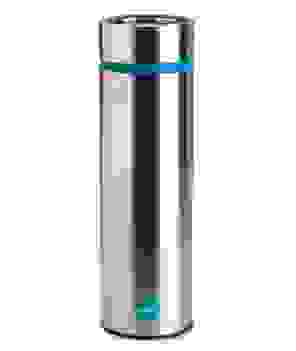
The recently launched Grayl, a stainless steel water purification bottle containing the mechanism entirely within the bottle, was invented by someone who got tired of all the annoying bottles that annoyed me too. But while I sat around complaining, she went out and made one.
While other options require sucking, squeezing, pumping, and other innuendo-laden activities, she wanted something that looked and functioned like a perfectly normal water bottle, with no silly contraptions required.
It turns out they work in my hometown, and I soon found myself at a business meeting, where they gave me a free one. I can only assume it was thanks to my devilish good looks and charm. Perhaps my impeccable comedic timing as well.
I’ve had it for a few days, and have obviously been filling and refilling, disassembling and reassembling, and examining it from every angle, to see how it stacks up against what I’ve used before, and to evaluate whether I’d feel good taking it with me on global adventures. I want just one thing that’ll work wherever. And I think this’ll do it.
Depending on which model you choose, it’s $50-$90 for all-in-one water filtration, in a classy package that’ll work just as well on the trail as it will in a board meeting. I mean, I’m not going to any board meetings, but maybe you are.
And although it seems like a crowded market, it really isn’t. The vast majority of filtered water bottles only filter large particles (thus letting tiny viruses right through), while purifiers only purify the water, killing whatever’s inside (thus letting chemicals right through). Either way, you’re still drinking icky things.
Grayl is one of the very few options that can remove everything, whether it’s chemical, bacterial, viral, or whatever, which is exactly what you’d want in developing countries with suspicious water supplies, along with additional options for more casual use, depending on your situation:
Filter options and cost-effectiveness
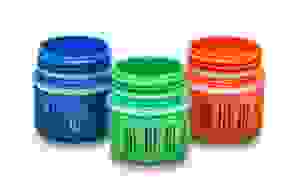
Grayl now offers three different filter types: Tap, Trail, and Travel, color coded for convenience and interchangeable with whichever bottle, providing varying levels of filtration:
- Tap ($15), designed for use at home, which removes chemicals and particles from tap water, making it taste great, averaging $0.10 per liter.
- Trail (discontinued), which removes everything the Tap filter does, along with 99.99% of bacteria, and 99.94% of protozoan cysts (like Giardia and Cryptosporidium), averaging $0.13 per liter.
- Travel ($25, now called the Purifier), which removes everything the Trail filter does, but goes up to 99.9999% of bacteria, 99.999% of protozoan cysts, and additionally removes 99.999% of viruses, averaging $0.26 per liter.
The titles correspond to suggested uses, and it’s nice that you can switch them out as needed, so you could take a Trail filter on a hike, or a Travel filter to Mexico, and switch it with a Tap filter when you get back home, and save the more serious filters for more serious situations.
And while many other purifiers only purify (leaving all the particles in the water) Grayl’s filters actually remove contaminants, so there’s no need for iodine-scented water. Water from the Grayl is just water.
Each unit handles about 150 liters, depending on the quality of the water you’re treating. Filling up from a muddy stream will clog things up faster, so stick with good water whenever you can.
Filtering with the Grayl
While competing products require sucking, squeezing, pumping, or waiting, the Grayl was designed to be as simple as drinking water out of a glass.
All you need to do is fill the lower chamber, and press the upper chamber into it, which pushes the water through the filter.
The better the filtration, the more time and pressure it takes to press: Tap, Trail, and Travel take 7, 15, and 30 seconds, respectively. The Tap filter is super smooth, but with the Travel filter, I usually look for a lower surface, like a coffee table or a chair, so I can press with my body weight, which makes pressing quite easy.
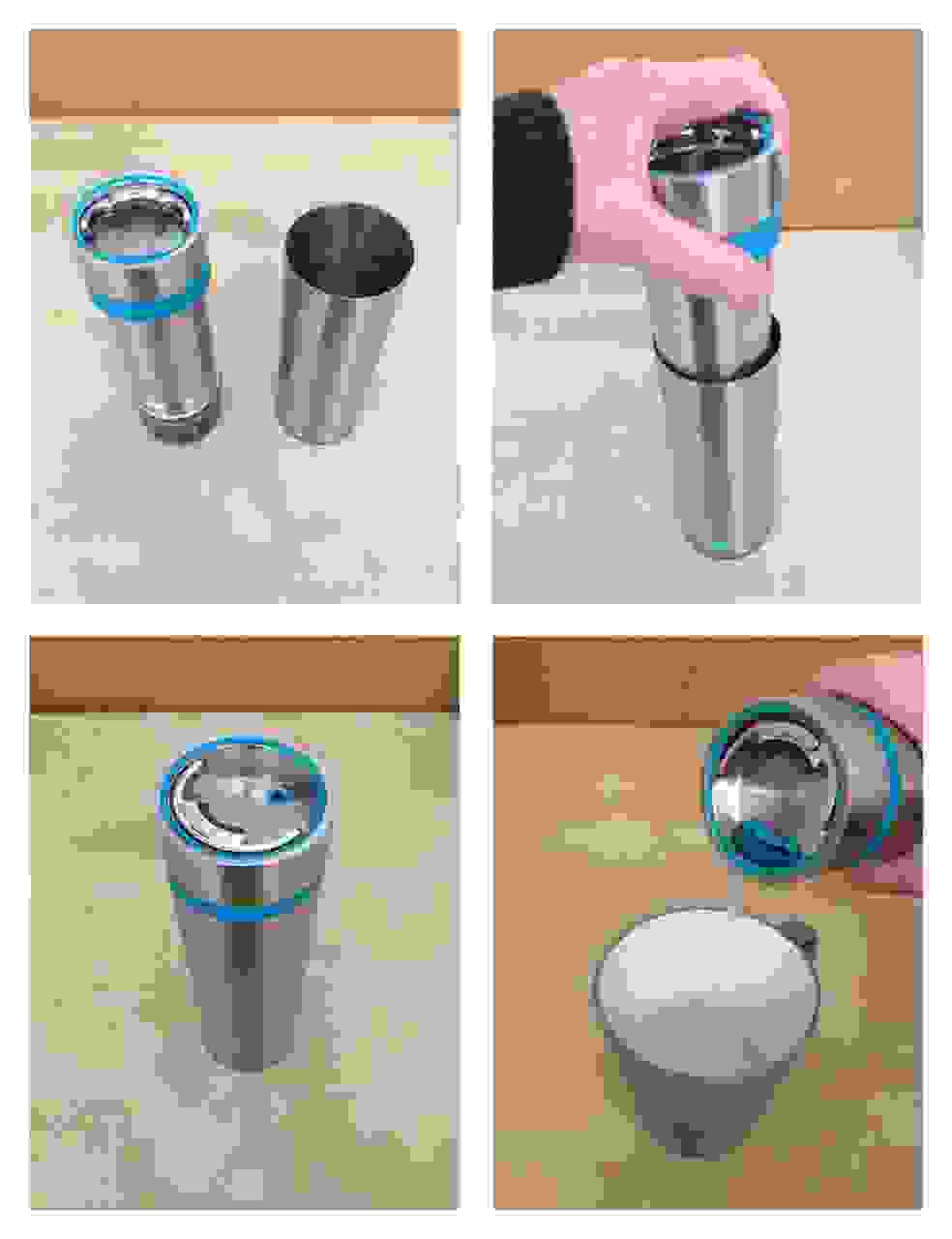
So it takes those extra 7 to 30 seconds (and maybe a little effort for the Travel filter) to get things going when you fill up, but that’s all you need to do until the next refill. And, as you can see, you can pour water from the bottle for friends, or fill up extra bottles for longer hikes where you won’t have access to more water. This is something most straw filter bottles just can’t do.
I can see certain situations where you might want a straw filter (biking, maybe), but this method allows for the convenience of no-suck drinking and pour-for-more-people functionality. Plus, you don’t have to drink from a sippy lid like a lil’ kid.
And just to compare the 30-second operation of the Travel filter with some other purification methods: UV lights take a minute, iodine tablets take half an hour, and others can take up to 4 hours.
One tip I’ll mention is that as you press the upper unit into the lower chamber, you have to keep it straight as you’re reaching the end. The upper unit can tilt a bit as you’re inserting it, and the lower unit can poke into the gasket if it’s tilting too much.
Drinking from the Grayl
I complain a lot about ease of use, as some of you may have seen in my pathologically-driven rant against every stupid water bottle on the planet, so I wanted to make sure the Grayl had a fairly simple locking mechanism that struck a nice balance between ease of use and security. Here’s how it works:
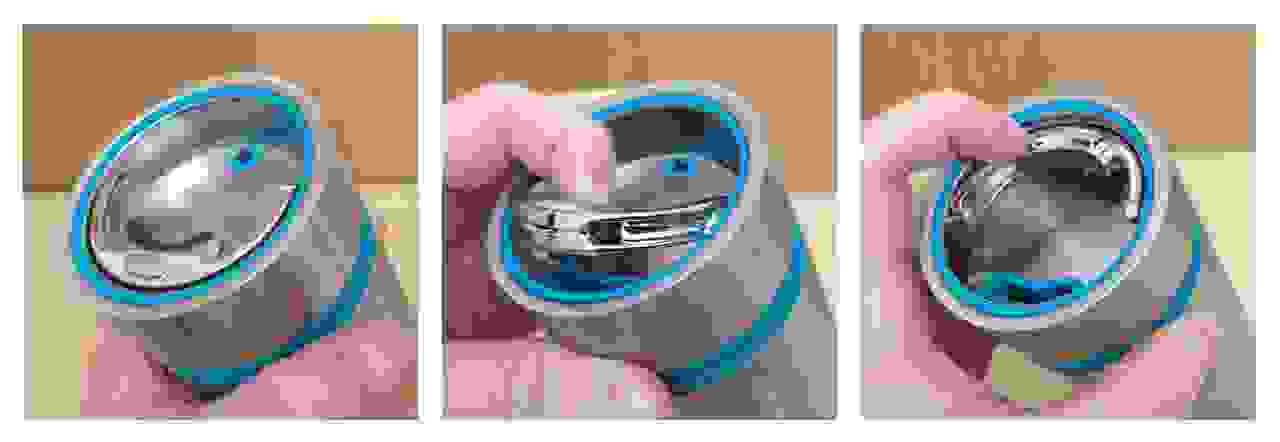
It’s quite simple. You push a button to release the lock, then flip the latch backward, where it clicks into place and releases a pressure valve, and then you drink. It’s not quite one-handed operation, but it’s very easy, and it’s positioned in a way that would make it quite difficult to open accidentally. I don’t expect I’ll need to stick a full water bottle into a backpack right next to a laptop, but I like having the option if necessary.
So I love the appearance, the simplicity of the filtration method, the option of the purifier, and the easy drinking mechanism. Plus, stainless steel is easy to wipe clean. It even fits in a car cup holder, and you can remove the filter and use it like a regular bottle, or remove just the lid, which allows you to fill it up without pressing the water through the filter, which is nice for people who already have clean water at home or the office.
It’s an all-around excellent design, which stacks up quite nicely against existing options. Which, at the moment, consist of just a few.
Other water purification bottles, aka the competition:
Though I’ve seen cheaper filters, they’re usually worse. Some don’t even filter bacteria. Just imagine the money you’d burn if you got sick and spent 3 days stuck in a hotel because you opted to save a bit on cheap filtration. And although good filters do exist (the Sawyer Water Bottle with Filter is an excellent filter-only bottle), they still won’t catch viruses. That might be okay at home or on the trail, but if you’re going anywhere with really questionable water, you really want better filtration.
I know of only a few other water filtration/purification bottles on the planet that can handle everything from large particles to the tiniest of viruses: The Katadyn MyBottle, which is similarly priced, but uses iodine to purify, thus affecting the taste; and the Lifesaver Bottle, which is a strong long-term investment if you’re planning on heavy use (it’ll become cost-effective after about 500 liters), but requires pumping to operate, which also makes it bigger and heavier. Both are worth a look, but the Grayl still compares quite nicely, whether on price or ease of use.
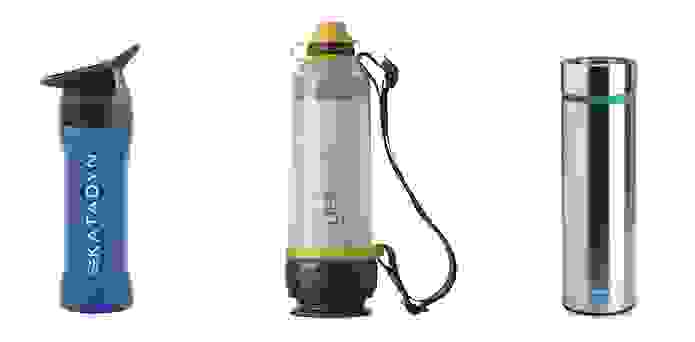
You can check out an in-depth comparison here (with a few updates as time has moved on).
But on a related note, part of the point of this whole thing was to design something that would not only filter water spectacularly well, but would also look classy at the same time. The Grayl was intended to work just as well at a business meeting as it does on the trail, instead of just being yet another sporty plastic water bottle. While you might shove all the others into a closet while at home, you might take the Grayl wherever you go.
But I also like the fact that I can mention its appearance as an afterthought. Its performance puts it on par with the best purifiers on the market, with cost-effectiveness comparable to long-time heavyweights like Katadyn, and its design eliminates the sucking, squeezing, pumping, and sippy straw operation of competing products. Even if you don’t care about aesthetics at all, it’s still one of the first things I’d recommend, especially since it can be your favorite water bottle at home, too.
Final Thoughts!
Anything I didn’t like?
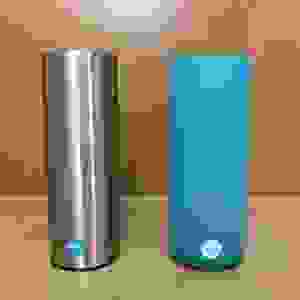
Well, I’ll mention the weight, which is about 20 oz (566 g) when empty, but there’s not much you can do if you want stainless steel construction, and besides, there’s now a lightweight option as well. Known as the Grayl Quest, it uses a plastic outer cup, reducing overall weight by about 20%, down to about 16 oz (453 g).
I’ve become quite attached to the stainless steel version, but ultralight minimalists might prefer the weight savings of the plastic. The pieces are interchangeable, so if you change your mind, you can replace the outer chamber without having to buy a whole new Grayl.
Update: As mentioned above, Grayl has launched the Grayl Ultralight, an all-plastic version that comes in at 10.9 ounces. If you’re backpacking, whether it’s the outdoorsy kind or the travel kind, that’s probably the one you want.
Though I expected the wide mouthpiece might cause some spills, this is rare. And I suppose the rubbery gasket that separates the upper and lower unit could be a little taller for added grip, but so far it feels fine.
It might be helpful to have some sort of attachment point, so you can hook it onto a bag, but I think that’s about it. Plans are already in the works for an accessory that’ll do that.
But it’s pretty tough finding fault with this thing, and these are definitely minor points. Overall, this’ll do it. It can be your one and only water bottle for whatever adventure comes your way. And it’s also nice to see that while other companies were sitting around for a decade not doing much of anything, these guys were working on something that could do it all, and look good, too.
Here they are, hard at work at the “office,” which is just whichever coffee shop they picked that week. They’ve really only just started.
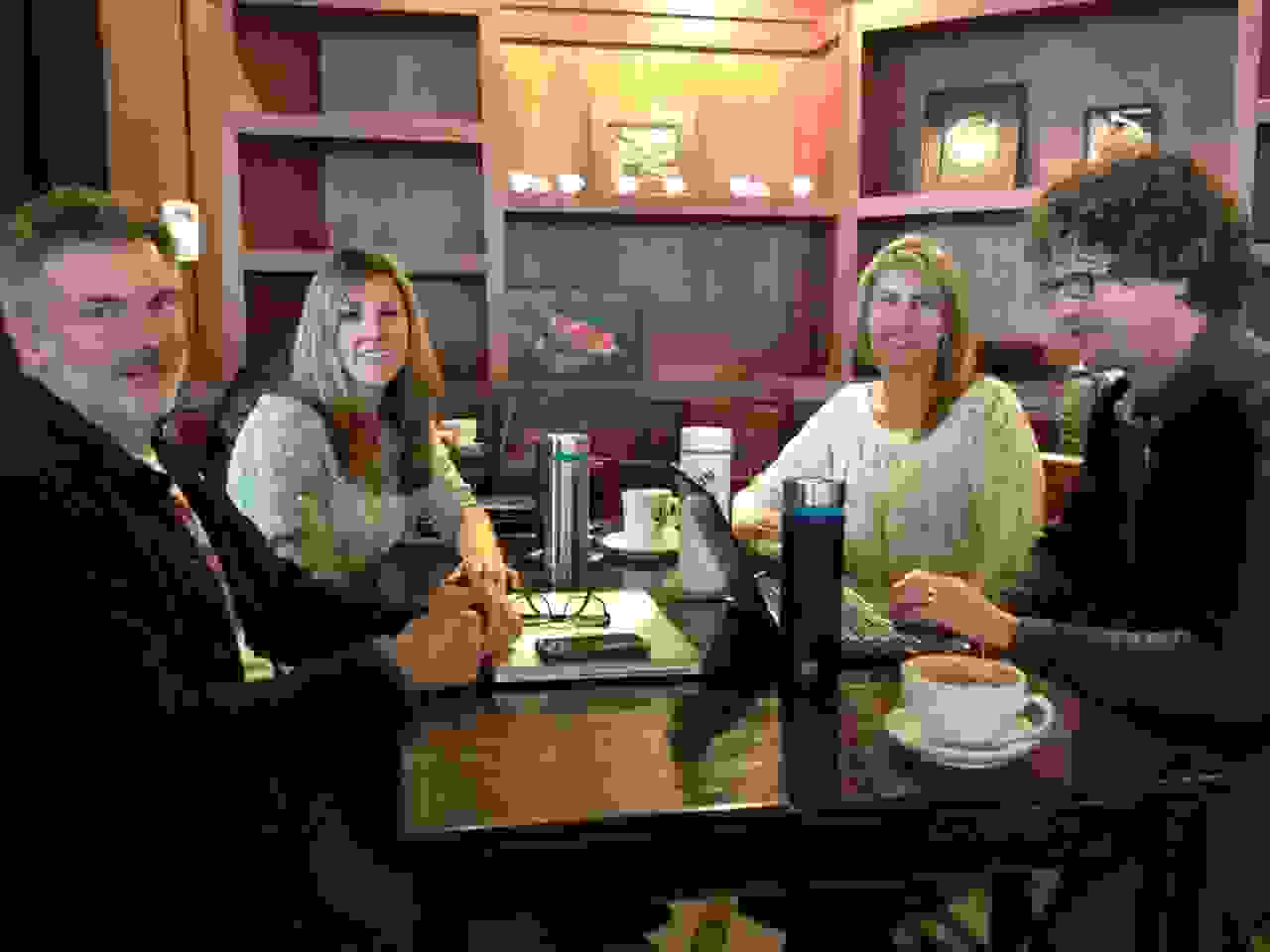
Thanks once again to the Grayl team for letting me be one of the very first to try this thing. It’ll be going on all sorts of adventures with me.
Grayl specs and purchase info
-
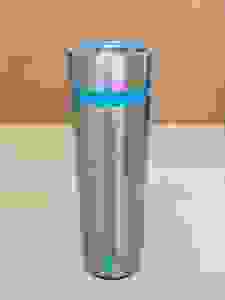
The Grayl, the silver bullet of water purifiers. No wait, NO! The Holy Grail! Dammit! Bottle price: $50-80 (plastic cup version), or $60-$90 (stainless steel cup version), with prices varying depending on the included filter unit of your choice.
- Replacement filters: $15 for the Tap filter, or $25 for the Purifier.
- Outer chamber replacements (if you decide to switch from plastic to steel, or vice versa): $12 for plastic, and $20 for stainless steel.
- Size: 9.1 x 2.8 in (23 x 7 cm)
- Weight: 16 oz (453 g) for the plastic version, and 20 oz (566 g) for the stainless steel version.
- Capacity: 16 oz (500 ml)
You can pick one up at TheGrayl.com.
As mentioned, they provided me with a free test sample, and, years after this review, made me a revenue-sharing offer as well, but I liked it long before then anyway.
Cheers.
Update! I just got back from a month in Guatemala, and didn’t buy water the whole time, using the Grayl (with the Travel unit, for the highest level of protection) to fill up from sinks and rivers, and it all worked out great. It came in especially handy on long hikes or late nights, with no open shops around.
A couple tips: I noticed that when you fly on a plane, the changes in air pressure can force the upper and lower chambers apart, causing a minor leak; I would recommend emptying it out completely before you fly, or filling it up all the way (since it’s just the air that expands or contracts) or just click it open while you’re in the air, to release the pressure, then close it again.
Also, the button on the latch eventually got a little stiff, making it more difficult to open, but scrubbing all over with a toothbrush fixed it right up. I expect it was just dust and grime that built up over time, so give this a try if you run into the same thing. Dropping a tiny droplet of cooking oil into the mechanism apparently works too.
All in all I’m quite happy with it!




Eytan. You can read my mind. This is actually what I was looking for lately. The water in China is so polluted and dirty I just can’t stand it. I had some spots on my back and I was thinking of buying something like this to purify the water before washing.
I like it a lot. I don’t know about using it to shower, though. Seems like you’d have to go through water pretty quickly! There are some pump filters and especially gravity filters that might work better for showering, since you set them up and leave them, and when you come back later you’ve got lots of clean water. But this is great for drinking.
The standard GRAYL is $70 with only the filter, so does that mean if you wanted the purifier it would end up costing $110?
Yes, that’s correct. I would recommend using the filter at home, and saving the purifier for travel, so you’re using the cheaper of the two options the majority of the time…unless you’re always traveling, of course.
I just went into “lighter-weight” backpacking (balancing light weight and my comfort and durability requirements, which are higher than pure LW backpackers) and your website has been a goldmine. So thanks for that, Snarky.
I bought a Steripen previously and was thinking of using it with a Sawyer filter bottle OR a Platypus GravityWorks Filter System to combine purification + filtration. Given that I can’t return the Steripen I still think I’ll do that, although I am tempted to go with the Lifesaver instead. What would you do? I’m primarily looking for a lightweight, practical and durable system. I also bought a couple LifeStraws but will probably keep those for the zombie invasion.
The Grayl looks great but I would make a couple suggestions for improvement:
– having to change the filter every 150L is too much of a hassle. I want something I can rely on for much longer. If they could make a premium version that last at least 10 times that, that would throw all other options out the window.
– consider titanium instead of plastic? I know I’m increasing cost here, but a lot of people would be ready to pay for a filter/purifier combo that’s super light, especially if it’s durable (see previous suggestion…)
Keep up the good work
Greg
The Sawyer/Steripen combo would certainly work fine, but it sounds like if you ever want an all-in-one design, the Lifesaver will be your…life…saver. Sorry, that was lame. But anyway, the Lifesaver is the one and only filtered water bottle with virus-level filtration that I know of that lasts as long as it does. I literally know of nothing else on the planet that even comes close, and its long-term cost-effectiveness is also exquisite. On the downside, it’s even heavier than the Grayl, though not by much, and requires pumping to operate, but that’s about it.
I was also just informed today about a UK company called Drinksafe, which has some rather impressive claims for their rather inexpensive filters. I’m going to do further research on them, but I thought I’d mention them here too.
And, of course, thanks for reading.
Drinksafe is interesting and certainly throws another option into the mix – thanks for bringing them up. I wish their website was a little clearer about the various products. But for me the need for replaceable cartridges is a turnoff, and they rely on those as well. In any case, I already went with the 3-way inline filter and the steripen for the virus. The only part missing is a carbon filter for taste and chemicals, but hiking in Canadian parks, I’ll take my chances on chemicals, and I’ll add colour flavouring when needed to neutralize taste – and test the filter at the same time by seeing whether the color goes through. I really like that the sawyer works as a gravity system as well. And the weight – I am around 500g in total.
On a different topic I ended up ordering Bluffworks pants, a Sea to Summit Ultra-Sil Pocket Daypack, and trying desperately to order Uniqlo airism boxer briefs as well (but they don’t accept canadian addresses… lame… please pressure them snarky-style to do so quickly!). So you are really driving my spending up. Thank you :)
Always happy to “help.” By the way, you can find plenty of brand new Uniqlo gear on eBay. It’s a little pricier, but oh well.
and here you go driving my spending again…
Recently purchased the Grayl. Great piece of kit.
I travel about 3 months a year to Asia, Europe, and South America. This is one of my best purchases for making life easier when i travel. No more waking up in an hotel and having to purchase the overpriced water from the mini bar. Or having to buy water to brush my teeth. Now i can just use tap water, filter it, and have confidence in it. The amount of bottled water i buy on trips will make this payoff in no time.
Workmanship is outstanding, as was their customer service. Even to a Canadian address :)
Randy
The toothbrushing situation is actually one of its advantages; filtered bottles with straws can’t be poured out onto something, since you have to suck up through the straw, so you can’t really brush your teeth with those, but this one can handle it.
Hi Randy,
Did you have any problems clearing airport security with the Grayl? I recently bought one and plan to use it for international travel but I usually travel light and don’t check bags so I’m hoping I can take it in my carry on.
Colleen
I flew with mine without a problem. It should be empty because of the maximum liquids rule, though. But aside from that it’ll just be up to whichever guard you get that day, but it looks enough like a travel mug that it should be fine.
Many thanks, SnarkyNomad!
Hi. I checked the Grayl web page, because I wanted to know more about those filters (filter and purifier). Differences is only in 1 layer of G3+media for filter and 2 layers of G3+media for purifier. If one layer is enough only for bacteria (probably 0,1 microns) how can be two layers of 0,1 microns enough also for viruses?
I hope you will understand my English ;-).
The viruses aren’t removed by filtration; they’re pulled out of the water, kind of like a magnet.
My discrepancy is that one layer is not enough but two layers are enough. Is second layer different as the first one? I don’t think so (based on webpage description).
Well, the regular filter cleans out bacteria, and the purifier also cleans out viruses, but I don’t know if that means it uses a different material or not. I just look at the testing statistics.
Hi Majo,
Good question – you’re right that the first and second layer are identical. Going from one layer to two makes a big difference in removing viruses.
In independent lab testing, a single layer removes 99.6% of viruses – very good, but not good enough to keep you safe abroad. The second layer has two effects. First, virus-laden water has to pass through twice as much of our material, catching even more of the bad stuff.
Second, the water passes more slowly. By slowing filtration, you can increase the effectiveness of any filter. In GRAYL’s case, slowing the filtration rate from 2.0 L/sec to 1.1 L/sec allows for consistent virus removal above 99.999%.
Of course, 1.1L/sec is very pretty fast for a filter that removes viruses.
Safe travels!
Hi,
We travel regularly to Hikkaduwa Sri Lanka, where we rent a house for a month at a time,and spend a lot of money on bottled water. My question is….would I need the extra filter when drinking the tap water there with the Grayl model.
I did buy water purifying tablets for this year’s visit, but it does mean you still have to have bottles to store all the water in for the day’s use, as it takes time to work ! We certainly saved a lot this year on bottled water, just bought a few to start us up, and to store the purified in.
Thanks for all your research tips…saves all of us out there from having to do it.
I’d use the purifier instead of the regular filter when in Sri Lanka, which will allow you to skip the tablets completely. You’ll be able to drink water that tastes just like water, and it’ll work in 30 seconds instead of the usual 30 minutes that it takes with most tablets.
Reading the differences between the standard filter and the purifier, apparently the purifier removes 99.999% of bacteria vs 99.99% for the standard and 99.999% of protozoan cysts vs 99.94% for the standard. For back country lakes and rivers in the US and Canada, is the purifier filter actually necessary?
Also, apparently the difference in construction is the purifier contains an extra filter layer. I am wondering if passing the water through twice would effectively achieve the higher purification.
I would say it’s better to be safe than sorry, but removing “only” 99.99% of bacteria is probably going to work out just fine. And I confirmed just the other day that the purifier simply uses 2 layers instead of 1, so I would expect that running the same water through the filter twice would work in theory, but then you’d get once-filtered water into the post-filtration chamber of the Grayl, meaning that some things would manage to get through. Plus you’d have only 1 filtration layer, so it probably wouldn’t last as long in that case. But I suppose if you find yourself in a situation where you have 2 Grayls, you could do it, as long as you go in the same order each time, so that the final phase is totally clean.
I’m glad you found this! I’ve used a basic katadyn filtering ‘stone’ to process large amounts of water for drinking and washing when I was by a river in a cabin by nowhere, and it worked okay. A film would build up on the stone and I’d have to scrub it off occasionally. But that was the two bucket method. This is good to know about for actual, on-the-move traveling. Thanks!
No problem. I was happy to have it on a recent trip, and it’s nice that it can be used in professional settings at home, too.
Hello,
This filter bottle has a plastic inside.
According to latest study about BPA contamination in plastics, and poisons all over any plastic, I started to look for water purifier which has no direct contact between water and plastic on any stage of filtering. Do you have something like that?
I will be waiting for your answer.
Thank you,
Best regards,
Martin
I’ve never seen a filtration bottle that was made purely of steel or glass, but the filter units in these are BPA-free.